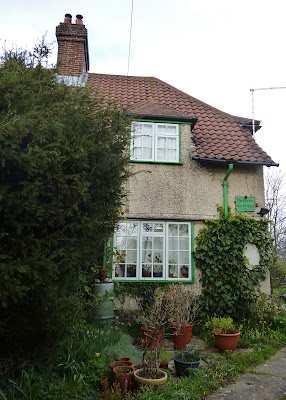Edward Thomas (1878–1917) moved from Kent to Steep, Hampshire, with his family in 1906, and this is where he became a poet.
The Red House on Cockshott Lane was the Thomas family's second home in Steep, and as the above plaque on the house records, he lived here from 1909 to 1913.
2 Yew Tree Cottages, which is set back a little from Church Road and reached by a short passage, was Thomas's last home in Steep, and from this building he enlisted in The Artists' Rifles in 1915.
The left window at Steep (shown above) shows a road across hills, with Thomas's jacket (taken from an original) in the foreground, along with his pipe and stick.
At the top of the engraving, behind the title, the house is depicted enshrouded in mist. Below it are a series of doors opening and shutting, the final one opening out onto a battlefield in Flanders. The explanatory notes 'Memorial Windows to Edward Thomas' conclude by saying that from the final door 'something rises that turns into the sun, and then the door-latch he has just closed behind him, in the poem'.
Many thanks to the churchwarden for bringing this picture out to show us.
On the opposite wall is this monument to the war dead in the parish.
And Edward Thomas's name is of course among them.
A very short distance away, on the corner of Mill Lane and Church Road, is another war monument.
It's the kind of thing you may sometimes miss if you don't occasionally step out from the car.
I give three links below, all concerning Matthew Hollis's Edward Thomas simply because Hollis is the most recent of Thomas's biographers. All come from the Guardian, the first two being video clips and the last an article on Thomas's relationship with Robert Frost and Hollis's (possibly none too original) take on the vexed reasons for Thomas's enlisting.
Unfortunately the White Horse Inn eluded me.
–––––––––––––––––––––––––––––––––––––––––––––––––
Matthew Hollis showing Sarah Crown Edward Thomas landmarks in Steep (10-minute video)
Matthew Hollis reading from his book Now All Roads Lead to France: The Last Years of Edward Thomas (4-minute video)
Edward Thomas, Robert Frost and the road to war, by Matthew Hollis
The Red House on Cockshott Lane was the Thomas family's second home in Steep, and as the above plaque on the house records, he lived here from 1909 to 1913.
2 Yew Tree Cottages, which is set back a little from Church Road and reached by a short passage, was Thomas's last home in Steep, and from this building he enlisted in The Artists' Rifles in 1915.
A similar plaque to the one in Cockshott Lane is also fixed to the wall here.
Thomas frequently took walks around the countryside, and Shoulder of Mutton Hill was one of his preferred spots.
This view gives another indication of the hilly countryside around the village, and shows the rear of Thomas's memorial stone, made in 1937, in the foreground.
'THIS HILLSIDE
IS DEDICATED TO THE MEMORY OF
EDWARD THOMAS
P O E T
Born in Lambeth 3rd March 1878.
Killed in the Battle of Arras 9th April 1917.
AND I ROSE UP AND KNEW
THAT I WAS TIRED
AND CONTINUED MY JOURNEY'
In 1978, to commemorate the centenary of Edward Thomas's birth, Laurence Whistler designed and engraved two windows for the south wall of the Church of All Saints, Steep. Seven years previously, Whistler had engraved a window remembering the lives of Edward and Helen Thomas in Eastbury, Wiltshire, where Thomas's widow moved to and where she lived until her death in 1966. She had written two books, As It Was and World without End, about her life with her husband. Helen's friend, the artist Joy Finzi, assisted in the commissioning and installation of the Eastbury window.
The above image shows a copy of the right window: the window itself was smashed by vandals in 1910. It showed Thomas's poem 'The New House':
The New House
Now first, as I shut the door,
I was alone
In the new house; and the wind
Began to moan.
I was alone
In the new house; and the wind
Began to moan.
Old at once was the house,
And I was old;
My ears were teased with the dread
Of what was foretold,
And I was old;
My ears were teased with the dread
Of what was foretold,
Nights of storm, days of mist, without end;
Sad days when the sun
Shone in vain: old griefs and griefs
Not yet begun.
Sad days when the sun
Shone in vain: old griefs and griefs
Not yet begun.
All was foretold me; naught
Could I foresee;
But I learnt how the wind would sound
After these things should be.
Could I foresee;
But I learnt how the wind would sound
After these things should be.
Many thanks to the churchwarden for bringing this picture out to show us.
On the opposite wall is this monument to the war dead in the parish.
And Edward Thomas's name is of course among them.
A very short distance away, on the corner of Mill Lane and Church Road, is another war monument.
It's the kind of thing you may sometimes miss if you don't occasionally step out from the car.
I give three links below, all concerning Matthew Hollis's Edward Thomas simply because Hollis is the most recent of Thomas's biographers. All come from the Guardian, the first two being video clips and the last an article on Thomas's relationship with Robert Frost and Hollis's (possibly none too original) take on the vexed reasons for Thomas's enlisting.
Unfortunately the White Horse Inn eluded me.
–––––––––––––––––––––––––––––––––––––––––––––––––
Matthew Hollis showing Sarah Crown Edward Thomas landmarks in Steep (10-minute video)
Matthew Hollis reading from his book Now All Roads Lead to France: The Last Years of Edward Thomas (4-minute video)
Edward Thomas, Robert Frost and the road to war, by Matthew Hollis


















No comments:
Post a Comment